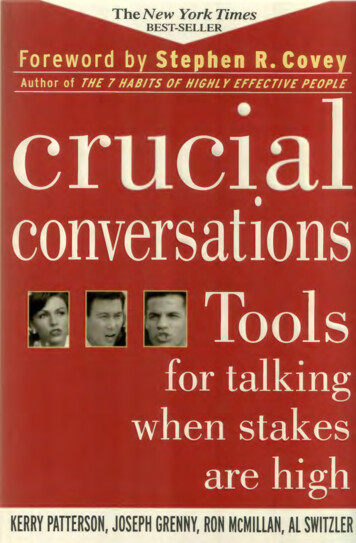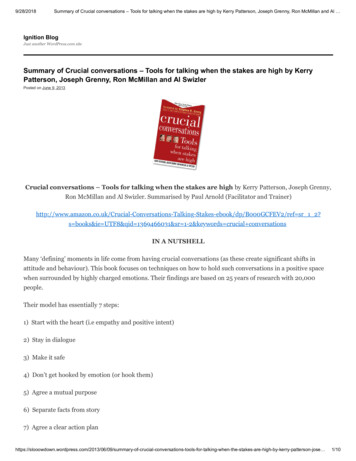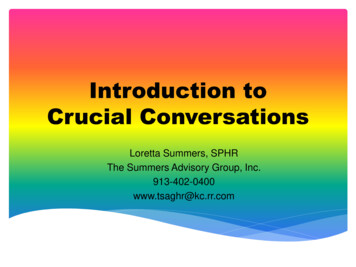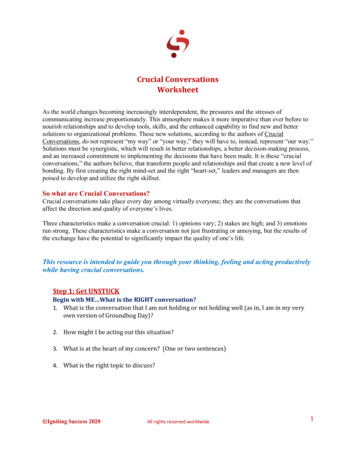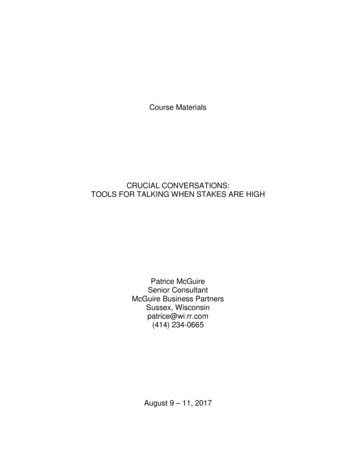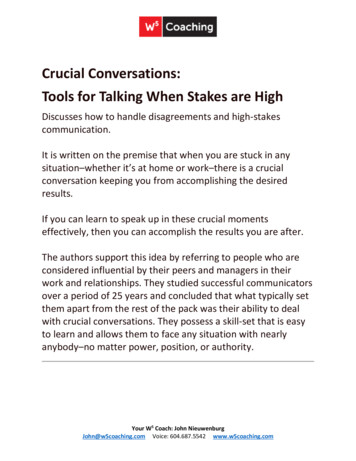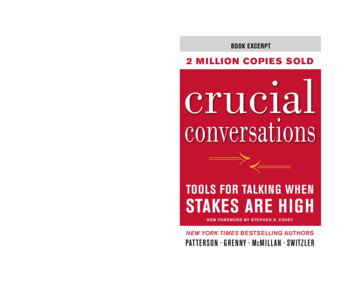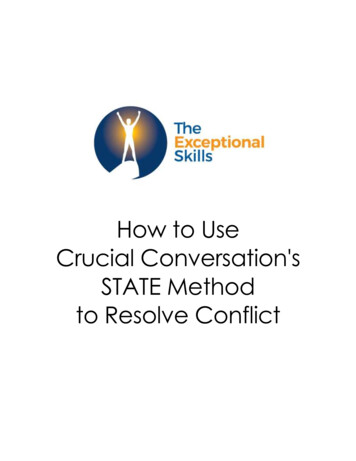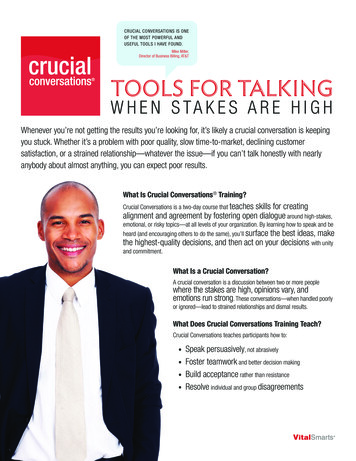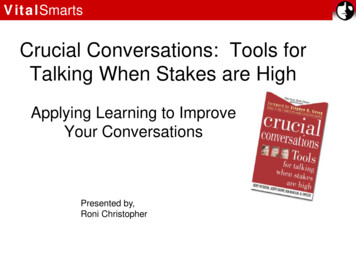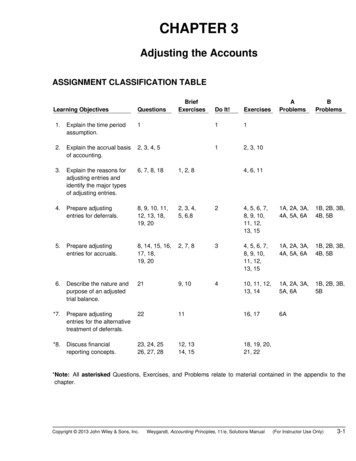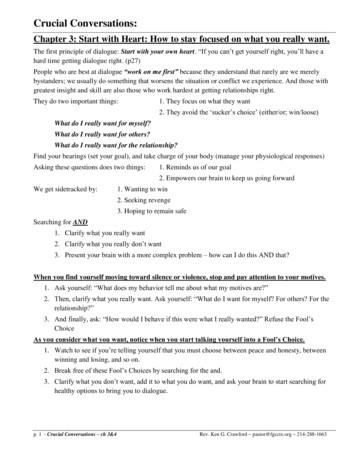
Transcription
Crucial Conversations:Chapter 3: Start with Heart: How to stay focused on what you really want.The first principle of dialogue: Start with your own heart. “If you can‟t get yourself right, you‟ll have ahard time getting dialogue right. (p27)People who are best at dialogue “work on me first” because they understand that rarely are we merelybystanders; we usually do something that worsens the situation or conflict we experience. And those withgreatest insight and skill are also those who work hardest at getting relationships right.They do two important things:1. They focus on what they want2. They avoid the „sucker‟s choice‟ (either/or; win/loose)What do I really want for myself?What do I really want for others?What do I really want for the relationship?Find your bearings (set your goal), and take charge of your body (manage your physiological responses)Asking these questions does two things:1. Reminds us of our goal2. Empowers our brain to keep us going forwardWe get sidetracked by:1. Wanting to win2. Seeking revenge3. Hoping to remain safeSearching for AND1. Clarify what you really want2. Clarify what you really don‟t want3. Present your brain with a more complex problem – how can I do this AND that?When you find yourself moving toward silence or violence, stop and pay attention to your motives.1. Ask yourself: “What does my behavior tell me about what my motives are?”2. Then, clarify what you really want. Ask yourself: “What do I want for myself? For others? For therelationship?”3. And finally, ask: “How would I behave if this were what I really wanted?” Refuse the Fool‟sChoiceAs you consider what you want, notice when you start talking yourself into a Fool’s Choice.1. Watch to see if you‟re telling yourself that you must choose between peace and honesty, betweenwinning and losing, and so on.2. Break free of these Fool‟s Choices by searching for the and.3. Clarify what you don‟t want, add it to what you do want, and ask your brain to start searching forhealthy options to bring you to dialogue.p. 1 - Crucial Conversations – ch 3&4Rev. Ken G. Crawford pastor@fgcctx.org 214-288-1663
Chapter 4 – Learning to Look: How to notice when safety is at risk“It‟s a form of social first aid. By watching for the moment a conversationstarts turning unhealthy, you can respond quickly. The sooner you noticeyou‟re not in dialogue, the easier it is to get back and the lower the costs.”What do you look for?1. The moment a conversation turns crucial – physical, emotional, verbal, behavioral signs2. Signs that people don‟t feel safe (silence or violence) – “people rarely become defensive simplybecause of what you‟re saying. They only become defensive when they no longer feel safe. Theproblem is not the content of your message, but the condition of the conversation.” When people don‟tfeel safe, they retreat or attack. That is when we should ask ourselves, “How can I increase theexperience of safety in this conversation?”Examples of Silence withholding information, blocking, covering, avoidingExamples of violence name-calling, monologuing, threats 3. What is your own Style Under Stress – become a vigilant self-monitor. Understand how youreact/respond and why.Learning to Self-MonitorIn Family Systems Theory we say, “Think systems, watch process.” In the present conversation, this meansthat we focus not only on the content of the conversation, but on the way the conversation is progressing,how each participant is behaving, and the broader environmental context. “What is really going on?” Weneed to learn to recognize our own feelings and thoughts about the discussion and the conversationpartners, not just the topic of conversation.Between every stimulus and response, there is a space. Our goal is to widen that space to provide sufficienttime for this self-monitoring. When your mother said, “If you get angry, count to ten,” she was teachingyou to create space between the stimulus and your response – between what someone said or did and howyou choose to respond rather than impulsively reacting.The distinction between react and respond can be helpful. Reactions are impulsive, instinctual, immediate.Responses are thoughtful, reflective, considered. Reactions are more likely driven by emotions, whileresponses incorporate understanding about higher goals and needs.One way to approach this from a faith perspective is to remember to “pray the pause.” That is, rather thanfilling that space by counting from 1-10 (or 100!) focus mind and heart in a prayerful posture of openreceptivity, asking for wisdom, guidance and peace, or extending grace, mercy and blessing to others.Also, ask a few trusted friends or colleagues to help you self-monitor. Give them permission to point out toyou what they see and hear from you in crucial conversations. Perhaps you have some patters of thought,speech or action of which you are unaware.Next, we will learn to create safe space, and to master our stories – the explanations we tell ourselves thatguide our words and actions.p. 2 - Crucial Conversations – ch 3&4Rev. Ken G. Crawford pastor@fgcctx.org 214-288-1663
STYLE UNDER STRESSThis 33-question assessment allows you to see how you respond in crucial conversations in a specific relationship. The resultsindicate your natural tendencies to move toward silence or violence as well as the dialogue skills or tools you use well orneed improvement in.The following questions explore how you typically respond when you’re in the middle of a stressful situation.Instructions:Relationship. Before you get started, think about the relationship you want to explore—with your boss, a coworker, adirect report, a friend, or family member—keep this relationship in mind.Circumstance. Next, think of a tough circumstance—one where you might slip into either silence or violence.Apply. Now, with that relationship and circumstance in mind, respond to the following statements as either true or FalseTrueFalseTrueFalseTrueFalseTrueFalse1.At times I avoid situations that might bring me into contact with people I’m having problemswith.2.I have put off returning phone calls or e-mails because I simply didn’t want to deal with theperson who sent them.3.Sometimes when people bring up a touchy or awkward issue I try to change the subject.4.When it comes to dealing with awkward or stressful subjects, sometimes I hold back ratherthan give my full and candid opinion.5.Rather than tell people exactly what I think, sometimes I rely on jokes, sarcasm, or snideremarks to let them know I’m frustrated.6.When I’ve got something tough to bring up, sometimes I offer weak or insincere compliments tosoften the blow.7.In order to get my point across, I sometimes exaggerate my side of the argument.8.If I seem to be losing control of a conversation, I might cut people off or change the subject inorder to bring it back to where I think it should be.9.When others make points that seem stupid to me, I sometimes let them know it without holdingback at all.10.When I’m stunned by a comment, sometimes I say things that others might take as forceful orattacking—terms such as “Give me a break!” or “That’s ridiculous!”11.Sometimes when things get a bit heated I move from arguing against others’ points to sayingthings that might hurt them personally.12.If I really get into a heated discussion, I’ve been known to be tough on the other person. In fact,they might even feel a bit insulted or hurt.13.When I’m discussing an important topic with others, sometimes I move from trying to make mypoint to trying to win the battle.14.In the middle of a tough conversation, I often get so caught up in arguments that I don't seehow I'm coming across to others.15.When talking gets tough and I do something hurtful, I’m quick to apologize for my mistakes.p. 3 - Crucial Conversations – ch 3&4Rev. Ken G. Crawford pastor@fgcctx.org 214-288-1663
lseTrueFalse16.When I think about a conversation that took a bad turn, I tend to focus first on what I did thatwas wrong rather than focus on others’ mistakes.17.When I’ve got something to say that others might not want to hear, I avoid starting out withtough conclusions, and instead start with facts that help them understand where I’m comingfrom.18.I can tell very quickly when others are holding back or feeling defensive in a conversation.19.Sometimes I decide that it’s better not to give harsh feedback because I know that it’s bound tocause real problems.20.When conversations aren’t working, I step back from the fray, think about what’s happening,and take steps to make it better.21.When others get defensive because they misunderstand me, I immediately get us back ontrack by clarifying what I do and don’t mean.22.There are some people I’m rough on because, to be honest, they need or deserve what I givethem.23.I sometimes make absolute statements like “The fact is ” or “It’s obvious that ” to be sure mypoint gets across.24.If others hesitate to share their views, I sincerely invite them to say what’s on their mind, nomatter what it is.25.At times I argue hard for my view hoping to keep others from bringing up opinions that wouldbe a waste of energy to discuss anyway.26.Even when things get tense, I adapt quickly to how others are responding to me and try a newstrategy.27.When I find that I’m at cross purposes with someone, I often keep trying to win my way ratherthan looking for common ground.28.When things don’t go well, I’m more inclined to see the mistakes others made than notice myown role.29.After I share strong opinions, I go out of my way to invite others to share their views,particularly opposing ones.30.When others hesitate to share their views, I do whatever I can to make it safe for them to speakhonestly.31.Sometimes I have to discuss things I thought had been settled because I don't keep track ofwhat was discussed before.32.I find myself in situations where people get their feelings hurt because they thought they wouldhave more of a say in final decisions than they end up having.33.I get frustrated sometimes at how long it takes some groups to make decisions because toomany people are involved.p. 4 - Crucial Conversations – ch 3&4Rev. Ken G. Crawford pastor@fgcctx.org 214-288-1663
Style Under Stress And Dialogue SkillsUse with the “Style Under Stress” 33 question assessment.SilenceMasking5 (T)6 (T)Avoiding3 (T)4 (T)Withdrawing1 (T)2 (T)ViolenceControlling7 (T)8 (T)Labeling9 (T)10 (10)Attacking11 (T)12 (T)Figure 4.1. Score Sheet for Style under Stress Assessment. A high score means you may use thistechnique fairly often.Ch 3: Start with Heart13 (F)19 (F)25 (F)Ch 4: Learn to Look14 (F)20 (T)26 (T)Ch 5: Make it Safe15 (T)21 (T)27 (F)Ch 6: Master my Stories16 (T)22 (F)28 (F)Ch 7: STATE my Path17 (T)23 (F)29 (T)Ch 8: Explore Others’ Paths18 (T)24 (T)30 (T)Ch 9: Move to Action31 (F)32 (F)33 (F)Figure 4.2. Score Sheet for Dialogue Skills Assessment. Reflects your skills in each of thecorresponding seven skill chapters. A high score suggests you may be skilled in this area. A low scorepoints to an area for improvement.p. 5 - Crucial Conversations – ch 3&4Rev. Ken G. Crawford pastor@fgcctx.org 214-288-1663
p. 2 - Crucial Conversations – ch 3&4 Rev. Ken G. Crawford pastor@fgcctx.org 214-288-1663 Chapter 4 – Learning to Look: How to notice when safety is at risk “It‟s a form of social first aid. By watching for the moment a conver
